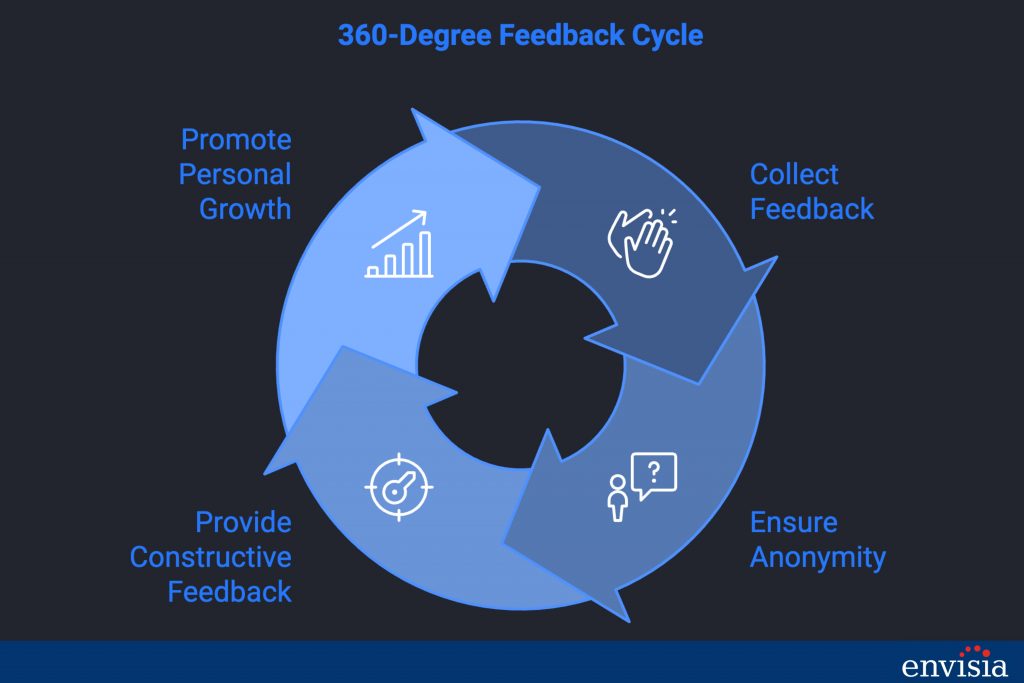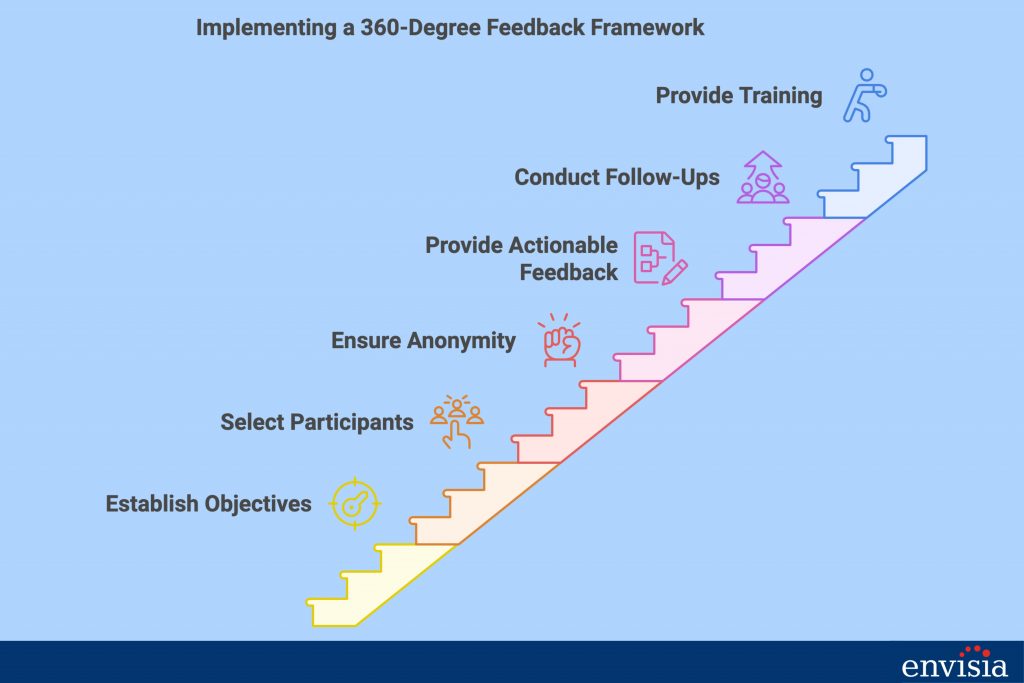Have you ever felt that traditional performance assessments don’t fully capture your contributions or the nuances of your interactions with your team? When you rely solely on your manager’s perspective, you risk inaccurate evaluations and unhelpful feedback, which can slow down your growth and development. This kind of feedback often misses the mark, leaving you without the valuable insights you need to improve. These days, modern HR practices require a more dynamic process for effective performance management.
That’s where the 360-degree feedback system makes a difference. By gathering insights from a range of people—managers, peers, subordinates, and even clients—you gain a well-rounded view of an individual’s performance. Using 360-degree feedback often allows managers to take proactive steps to inspire and motivate their teams. In this article, you’ll learn about every aspect of the 360-degree feedback process, from its benefits to the best practices for planning and execution.
We’ll also explore how this multi-rater feedback system has been used to enhance your HR practices, align goals and competencies, and ultimately improve the impact on employee development.
Key Takeaways
- Comprehensive Performance Assessment: 360-degree feedback provides a well-rounded evaluation by collecting input from a diverse range of people, giving you more accurate and valuable feedback.
- Effective Implementation Requires Planning: To get the most out of 360-degree feedback, you’ll need a solid plan—start by choosing the right raters and aligning everything with your organizational goals and competencies.
- Enhances Growth and Development: When done right, 360-degree feedback can significantly impact employee growth and development, helping you inspire and motivate others while moving your HR practices forward.

What Is a 360-Degree Feedback System?
A 360-degree feedback framework is a performance management system that collects valuable input from multiple sources, including your manager, peers, direct reports, and sometimes clients or external partners. Unlike traditional performance appraisals, which rely on a single evaluator, the 360 review process gives you a broader and more balanced view of your strengths and areas for improvement. This creates a clear path for employee development.
The feedback is usually collected anonymously to encourage honesty and reduce bias. When you receive this kind of anonymous feedback, you get a fuller picture of how your actions impact those around you—whether it’s your colleagues, team members, or supervisors. Ultimately, the 360 feedback process supports personal growth by offering you constructive feedback to help you understand your strengths and where you can improve.

Benefits of the 360 Degree Feedback Method
Implementing a 360-degree feedback process gives you a holistic view of an employee’s performance, something that traditional performance reviews often miss. By gathering feedback from direct reports, peers, and supervisors, you can strengthen teamwork and gain valuable insights for both you and your leadership team.
Using 360-degree feedback keeps communication open and helps you spot areas for development. Feedback recipients can then create action plans that drive both personal and organizational growth. You’ll find that when employees can select their raters, they’re more engaged and invested in the feedback process.
Of course, feedback must be managed carefully to be effective, but the benefits—like more accurate performance evaluation and greater overall efficiency—are well worth the effort. Think about how much turnover could drop, how much morale could rise, and how much better your team would feel with regular, open feedback through a well-executed 360-degree feedback system.
Curious about how these benefits could transform your organization? Dive into our detailed article on the Benefits of 360 Degree Feedback.
Best Practices for Implementing a 360-Degree Feedback Framework
Successfully setting up a 360-degree feedback process requires thoughtful planning, smooth execution, and continuous support. Here are some of the best practices to help you get the most out of your 360-degree feedback system:

1. Establish Clear Objectives
Before you kick off a 360-degree feedback process, take some time to establish clear objectives. What do you want to achieve? Are you looking to improve individual performance, boost communication and collaboration, or develop leadership skills? Setting these goals will help you ensure the feedback process aligns with both individual and organizational objectives.
When you’re clear about the goals, employees will see how the feedback helps them grow, making them more open to the process.
2. Select the Right Participants
Choosing the right raters is critical to the success of your 360-degree feedback process. You need participants who work closely with the employee and can provide useful, actionable feedback.
Typically, this includes managers, peers, and direct reports who know the employee’s work well. By selecting a diverse group of reviewers, you’ll get feedback that reflects the employee’s performance across different roles and relationships. Balanced insights are essential for a successful 360-degree feedback process.
3. Ensure Anonymity and Confidentiality
Anonymity is a big part of why 360-degree feedback works. Keeping the feedback providers anonymous creates a safe environment where participants can be honest. Your team is more likely to share helpful feedback when they know it won’t be traced back to them, which reduces bias and encourages open communication.
At Envisia, we make sure your feedback remains confidential and secure, protecting relationships in your organization. With our platform, your employees can trust that their feedback will be used constructively, fostering a culture of openness and continuous improvement.
4. Provide Actionable Feedback and Development Plans
Feedback that’s vague or unclear won’t help anyone. Make sure the feedback collected through your multi-source review is specific, actionable, and constructive. Once you have all the feedback, create detailed development plans with clear guidance on how to improve.
These plans should include specific, measurable goals and a timeline for achieving them. This structured approach ensures the feedback leads to real growth and improvement.
5. Conduct Regular Follow-Up for Continuous Improvement
The 360-degree feedback process doesn’t end once you deliver the feedback. Regular follow-ups and ongoing coaching are essential to ensure the feedback leads to lasting change. Managers should work with employees to review the feedback, check progress, and adjust development plans as needed.
Regular check-ins help employees stay on track. You’ll also have opportunities to revisit goals and strategies over time, keeping the process dynamic and ensuring long-term growth.
6. Provide Training on How to Give and Receive Feedback
One of the biggest challenges with 360-degree feedback is making sure participants know how to give and receive feedback in a way that’s helpful. Not everyone is comfortable giving feedback that’s both honest and constructive. Offering training on best practices for delivering feedback can help participants learn how to share their insights productively.
It’s also important to train employees on how to receive feedback without getting defensive. If you can help your team see feedback as a tool for growth, you’ll reduce tension and resistance, making the process much more effective.

Overcoming the Drawbacks of 360-Degree Feedback
While the 360-degree feedback approach offers many advantages, it also comes with potential challenges you’ll need to address. Here are some common issues and how to overcome them:
1. Time-Consuming Process
360-degree feedback can take time, especially when you’re gathering feedback from multiple sources. Coordinating with many raters, compiling all the data, and delivering the feedback requires time and effort.
To make things easier, consider using feedback management software to automate many of the administrative tasks. Setting clear timelines and expectations for participants also helps reduce delays.
2. Potential for Bias
Bias can creep into 360-degree feedback, particularly if personal relationships affect how feedback is given. To minimize this risk, ensure your review framework includes a diverse group of appraisers and keep the feedback anonymous.
Training raters to provide fair and objective feedback will also help reduce personal bias, leading to more accurate and helpful feedback.
3. Resistance to Feedback
Some employees may resist feedback, especially if it highlights areas they didn’t know needed improvement. Help them see feedback as a tool for growth rather than criticism. If framed the right way, even tough feedback can fuel personal and professional growth.

Conclusion
A 360-degree feedback system offers a dynamic and comprehensive approach to performance management. By implementing this feedback process, you can foster continuous growth, improve employee performance, and gain multi-faceted insights that drive long-term success. When you overcome the potential drawbacks and follow best practices, your organization can get the most out of the 360-degree feedback process.
Setting clear objectives, choosing the right participants, and providing actionable feedback are all key to building a successful 360-degree feedback program. Whether you’re implementing 360-degree feedback for the first time or fine-tuning an existing system, these steps will help you get better results for both your employees and your organization.
Imagine the improvements in turnover rates, morale, and company culture when you create a culture of continuous development, trust, and openness. By keeping your organization competitive and aligning individual and organizational goals, you’ll set yourself up for long-term success.
